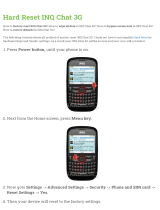
CGI Command Manual
2
Contents
1 About this manual .................................................................................................................................. 4
2 Motion video request commands ........................................................................................................... 6
2.1 Acquiring MPEG-4 or H.264 bit stream ........................................................................................... 6
2.2 Acquiring multiplexed Audio & Video bit stream ............................................................................ 12
3 Audio data request command .............................................................................................................. 15
4 Audio output request commands ......................................................................................................... 17
5 Still image request ............................................................................................................................... 18
6 Setting commands of camera parameters ........................................................................................... 19
7 Inquiry commands of camera parameters ........................................................................................... 20
8 Control commands for Panning, Tilting, Zooming and Focusing ......................................................... 22
8.1 relative parameter (syntax: relative=aabb) .................................................................................... 22
8.2 AbsolutePanTilt parameter ............................................................................................................ 23
8.3 AreaZoom parameter (syntax: AreaZoom=x,y,w,h,<codec>) ........................................................ 24
8.4 ContinuousPanTiltZoom parameter (syntax: ContinuousPanTiltZoom=<pan speed>,<tilt
speed>,<zoom speed>) ...................................................................................................................... 25
9 Configuration command for motion object detection or unattended object detection .......................... 26
9.1 Common configuration terms ........................................................................................................ 26
9.2 Inquiring the configuration ............................................................................................................. 27
10 Information request command ........................................................................................................... 28
11 CGI command list .............................................................................................................................. 30
11.1 System ........................................................................................................................................ 30
11.2 Exclusive camera control ............................................................................................................ 41
11.3 Date and time .............................................................................................................................. 41
11.4 Pan/Tilt/Zoom .............................................................................................................................. 42
11.5 Focus/Zoom ................................................................................................................................ 48
11.6 Camera ....................................................................................................................................... 50
11.7 Privacy mask ............................................................................................................................... 62
11.8 Sense up ..................................................................................................................................... 64
11.9 Serial ........................................................................................................................................... 67
11.10 Network ..................................................................................................................................... 68
11.11 Wireless network ....................................................................................................................... 70
11.12 Filtering ..................................................................................................................................... 72
11.13 QoS ........................................................................................................................................... 73
11.14 Dynamic IP address notification ................................................................................................ 74
11.15 SSL / TLS .................................................................................................................................. 75
11.16 802.1X ....................................................................................................................................... 76
11.17 Viewermode .............................................................................................................................. 77
























